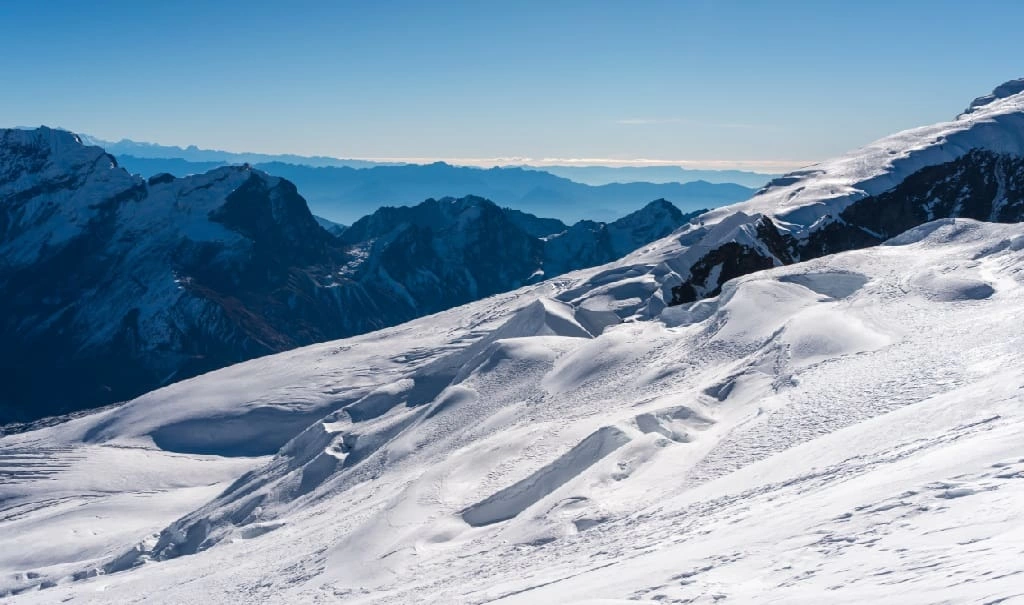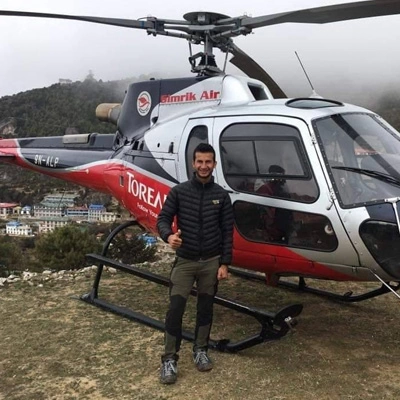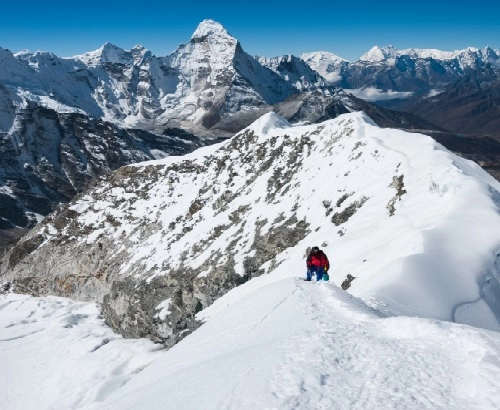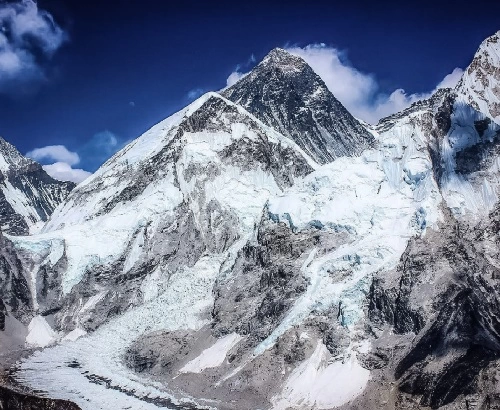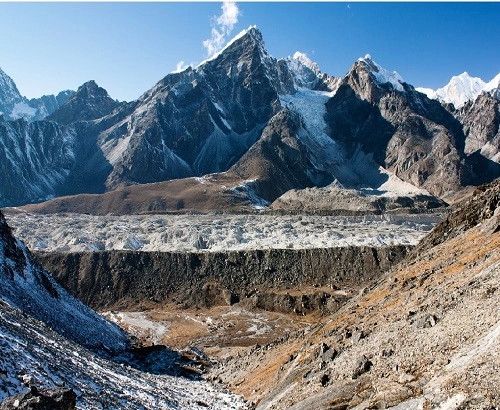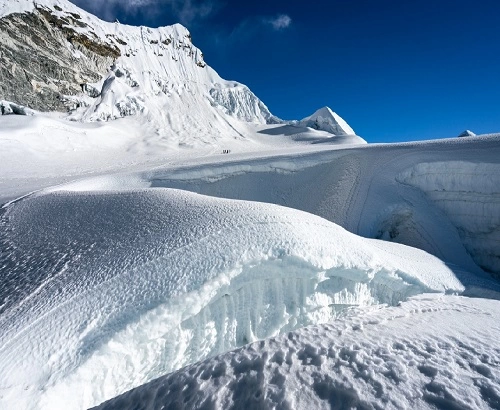Mera Peak Climbing is an adrenaline-packed 17-day journey to the famous trekking peak in Nepal. The mountain is far south of Mt. Everest and lies on the premises of the Makalu-Barun National Park. It presents a remarkable climbing experience and a spectacular view of gigantic mountains. You don't need to be an experienced climber with the technical climbing experience of covering a hundred miles to climb this peak. You can easily conquer this peak climbing journey with fundamental mountaineering skills, knowledge of high-altitude treks, passion, and confidence. Come with us on the Mera Peak Climbing From Kathmandu Package and let the professional mountain guide who has summited almost the highest mountain guide you on this famous non-technical peak of Nepal in the Everest region.
Mera Peak Climbing 17-Day Package Overview
Mera Peak Trek with Climb 17 Days Journey is the peak climbing package to choose from if you crave adventure, love climbing mountains, and want to explore new places. This thrilling journey takes you through forests, valleys, and glaciers until you reach the summit of Mera Peak. At 6476M, it's one of Nepal's highest trekking peaks and offers breathtaking Himalayan views. With experienced guides, comprehensive amenities, and a challenging but achievable goal, this package has everything you need.
Despite being non-technical, this climbing Mera Peak adventure is not for the faint of heart. Rising over 6476M, Mera Peak is among the highest trekking peaks in the Himalayas. The climb requires crampons, ice axes, and ropes, but the rewards of standing on top of the snow-capped summit are well worth the effort.
Mera Peak Climbing's 17-Day Detailed Itinerary begins with a scenic flight from Kathmandu to Lukla, followed by a trek through picturesque Sherpa villages and rhododendron forests to Mera Base Camp. After a day of acclimatization and ice climbing training, you'll make a summit bid, climbing over the snowy slopes of Mera Peak. Two summit days are planned in case of bad weather.
Reaching the summit of Mera Peak requires determination and stamina. The Climb to Mera Peak is technical, involving steep ice walls and rocky scrambles. However, many amateur climbers have achieved this thrilling feat with the help of experienced Sherpa guides and porters. The rewards from the top are unparalleled—views stretching from Makalu to Everest, an ocean of snow peaks as far as the eye can see.
An added highlight of this Mera Peak Climbing From Kathmandu adventure is the opportunity to experience authentic Sherpa culture. You'll stay in cozy teahouses in remote villages, eating traditional meals and learning about the local way of life. The scenic trek through the Hinku and Hongu valleys is a cultural journey, allowing insight into the daily lives of mountain peoples who inhabit this rugged region in the shadow of the Himalayan giants.
Join us on a 17-day-long Mera Peak Climbing expedition from Kathmandu. This expedition suits thrill-seekers who want to combine excitement with a fantastic view. Our guided tour is for advanced or beginner climbers who wish to sign up for Nepal's best trek and climbing adventure. Experience the best climbing experience in autumn/spring, the peak season for various activities. If you are an adventure seeker, Adventure Altitude Treks has a great offer on excursions 2025, 2025, and 2026 at a special discounted price with no compromise in quality. Put your trust in our local guides, who have the experience to make the climbing process successful and safe.
Mera Peak Climbing 17-Day Highlights
- Journey to the summit of Mera Peak (6,476 meters), the greatest trekking peak in Nepal.
- The basic mountain climbing experience that beginners can use to evaluate their skill and experience levels.
- The breathtaking sight of the five highest summits in the world - Makalu, Kanchenjunga, Cho Oyu, Lhotse, and Mount Everest
- Transverse the Mera Peak trek and Climbing route, where you can see rhododendrons, pine, and fir trees with the tall Himalayas backdrop, waterfalls, rivers, and pasture lands.
- Visit the settlements of the multicultural community, which has a rich tribal culture embedded and inspired by Tibetan and Buddhist values.
- Climbing Mera Peak in the autumn package allows you to cross one of the amazing Himalayan passes, Zatrawal Pass, at 4,600 meters.
- The climb is one of the most accessible climbs in Nepal for mountaineers with little experience who wish to climb their first mountain.
- Go on a less crowded pathway with breathtaking views.
- Easy booking policy for the Mera Peak Climbing Package
- Hike through the villages of Thaknak and Khare, etc., which are artfully situated off the beaten paths.
Mera Peak Trek with Climb 17 Days Package Benefits With Us
Here are a few benefits for the traveler who chose us for their adventure below:
- You will have support from professional guides throughout your journey, from the guiding team who will accompany you until you reach Base Camp to the climbing guide leading you to the top of Mera Peak.
- The packages are available in autumn and spring when the weather is favorable. Therefore, the maximum chance of success is highly expected.
- Take advantage of discount rates for group reservations on Mera Peak Climbing From Kathmandu trip, to make the experience inexpensive and engaging.
- Easy package booking process in 2025 and 2026
- We at Adventure Altitude Treks provide a Duffle Bag. This bag is lightweight and comfortable to carry while ascending.
- Medical kits are added to the package so that emergency supplies or medical care can be assured in an emergency or medical needs arise.
- A free Mera peak climbing map is provided. It has a well-organized route with 1-2 days for acclimatization.
Is Mera Peak Climbing 17-Day Package Suitable For Me?
So, you've set your sights on conquering one of the best trekking peaks in Nepal. Mera Peak offers stunning views and a challenging climb. But before you book your trek, ensure this adventure suits your fitness level.
- Have you done any high-altitude climbing before? While Climb to Mera Peak Journey doesn't require technical climbing skills, the high elevation (over 21,000 feet!) can be taxing. If this is your first high-altitude trek, prepare to take it slow and listen to your guide. But with some solid training and determination, Mera Peak is absolutely within reach for novice climbers.
- This trek requires a high level of endurance and stamina. It would be best if you were comfortable hiking 6-8 hours daily for multiple days, often at high elevations. Before setting off for the 17-Day Mera Peak Climbing Trip focus on cardio exercises like running, swimming, or biking. Strength training your legs and core will also help. If you stick to a regular workout routine, you'll be ready to take on Mera Peak.
- The higher you climb, the less oxygen in the air. Not everyone adapts well to high altitude; altitude sickness can be dangerous if not taken seriously. The best way to prevent altitude sickness on your Mera Peak Climbing 17-Day adventure is to allow enough time for your body to acclimate as you ascend. Drink plenty of water, avoid alcohol, and be on the lookout for symptoms like headaches, nausea, or dizziness. If you experience severe symptoms, descend immediately.
- The Mera Peak climb is an ideal trek for physically fit adventurers. By training hard, allowing time to acclimate, and listening to your body, this magical trek in the Himalayas could be the thrill of a lifetime.
Can A Beginner Go For Mera Peak Climbing From Kathmandu 17-Day Package?
Mera Peak can be a great first challenge if you're new to mountaineering but eager to tackle a Himalayan peak. While the 17-day trek requires endurance, the technical difficulty is relatively low, making it suitable for beginners with some preparation.
- You must be physically healthy to complete the Climb to Mera Peak Journey comfortably. Start training months in advance by hiking, jogging, and doing strength exercises.
- The trek involves long days, up to 8 hours of walking, often at high altitudes. Be ready for ascents up to 1,500 feet in a day. If you're not accustomed to intense cardio exercise, build up your endurance over time.
- Mera Peak reaches over 21,000 feet, so altitude sickness is a risk. Go slowly, stay hydrated, and watch for symptoms like nausea, headaches, and shortness of breath. Descend immediately if they appear.
- As a beginner going on the Mera Peak Climb in the Spring 17-day adventure, I work with an experienced guide service that provides quality gear. Be prepared for variable weather by packing layers, insulation, rain jackets, hats, gloves, hiking boots, and thermal undergarments. Your safety gear should include sunglasses, sunscreen, basic first aid supplies, and important medications.
- With the help of experienced guides and Sherpa porters, your 17-day Climb of Mera Peak can be safe and unforgettable. Mera Peak provides a real sense of accomplishment and perspectives that will stay with you for life.
17-Day Mera Peak Climbing Cost for 2025, 2026, and 2027
The Mera peak climbing package costs $1800 per person and can reach up to $2200 per person. The more people you have in a group, the more discounts you get with us at Adventure Altitude Treks. We offer all kinds of trips, such as solo, private, or group peak climbing, at different cost ranges with varying discounts for 2025, 2026, and 2027. The package cost includes a detailed Itinerary and map, transportation, accommodation, meals, a guide, etc.
Here is a look at the group Mera Peak Trek with Climb 17 Days package cost below:
Pax | Cost Per Person | Inquiry |
1 - 1 | $2200 | Send Inquiry, Contact Us |
2-3 | $2150 | Send Inquiry, Contact Us |
4-6 | $2050 | Send Inquiry, Contact Us |
7-9 | $2050 | Send Inquiry, Contact Us |
10-16 | $2000 | Send Inquiry, Contact Us |
17-30 | $1800 | Send Inquiry, Contact Us |
